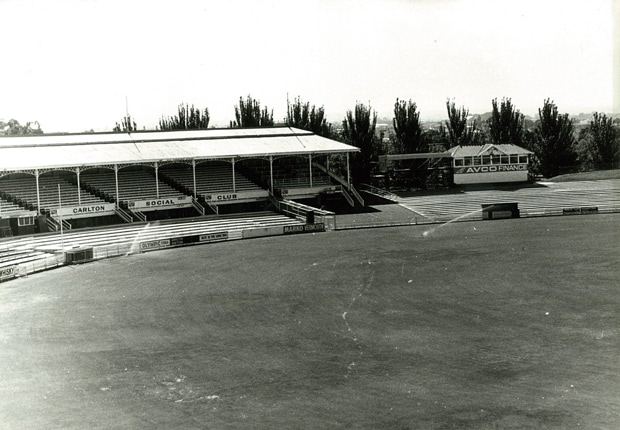It stands defiantly, one of the few surviving early 20th century grandstands flanking a VFL sporting arena.
It carries the name of Victoria’s first captain, a leviathan of the Carlton Football Club both on the field and off it.
And yet the identity of its architect remains unknown, more than 100 years since Members and supporters first took their places in it to cheer on their heroes.
Dedicated to John Gardiner, the Ald. Gardiner Stand, with its classic Edwardian features, to this day retains its aesthetic and historical significance as the maiden substantial structure to grace the Carlton Recreation Ground (read Princes Oval, Princes Park, Optus Oval, MC Labor Park, Ikon Park).
Records retained by the club indicate that around 1907-08 an unnamed architect was appointed to prepare drawings for a grandstand, which evidently had some effect in bringing the Carlton Cricket Club to the party.

The Gardiner Stand 1913, with old Triangle Stand in foreground. (Photo: Carlton Media)
By 1908, £800 had been set aside for the grandstand from takings by the football club. Another £400 was proposed to be borrowed separately each by the football club and the Ground Committee, together with £1 debentures, at the rate of five per cent over ten years, to be issued to raise the balance in the event members of the Cricket Club indicated a willingness to become guarantors for £1200 in lieu of the proposed loan by the four-man Ground Committee - amongst them Carlton’s first 200-game player Rod ‘Wee’ McGregor.
The cost estimate, provided by Spargo and Taylor (the lowest successful tenderers), was £3397 to build a five-bay grandstand. By 1909 the grandstand had become a reality, if unfinished.
By the time the grandstand was fully completed in 1912, membership of the Carlton Football Club totalled 5039, comprising 4009 members, 934 ladies, 16 donors, 32 life members, 32 players and eight trainers.

Gardiner Stand and Press Box, 1984. (Photo: Carlton Media)
The Gardiner Stand is considered is of outstanding significance at the local level and in comparison with the few surviving other grandstands of this era.
But the identity of the architect remains one of Carlton’s great mysteries.



